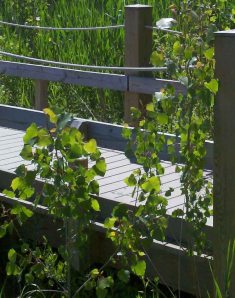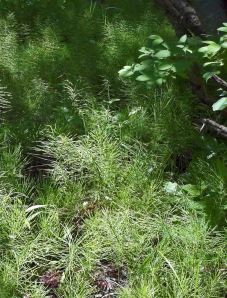A June blizzard and other surprises at an NYC salt marsh
This is a report on our fifth visit to a salt marsh and surroundings at the northern end of Alley Pond Park where we are documenting the progress of spring.
By Len Maniace
A blizzard of white puffs blew through the park Monday, piling up on paths and grass, and even coating ponds. They are cottony strands that hold seeds, which until recently were growing inside the seed pods of the eastern cottonwood tree.
In the last few days the pods have burst open, allowing the seeds of Populus deltoids to take flight in the breeze and disperse through the park’s salt marsh and surroundings. A walk on the boardwalk to the salt marsh at the northern end of Alley Pond Park shows just how effective this means of dispersion is. A scattering of fast-growing, young cottonwoods poke through lower growth.
Though the cottonwood puffs are a highlight – young students on nature walks repeatedly ask about them – there are other changes in the three weeks-plus since our last visit. Trees have leafed out in abundance, so that some views once-filled with blue sky are blocked by a thick green canopy. Even a black walnut tree (Juglans nigra) has finally leafed out, though it looks stunted compared to nearby oaks, red maples, weeping willows, and cottonwood trees which responded to spring sooner. This native is prized for its nuts and especially by furniture makers for its hardwood.
As usual on these visits, we set out for the salt marsh. We’re accompanied by our usual guide, Aline Euler, curriculum and grant developer at the Alley Pond Environmental Center. Housed in the Alley Pond Park just off Northern Boulevard, the center provides educational programs about the salt marsh and vicinity for children and adults.
No sooner than we leave the center, we spot a wild rose (Rosa multiflora) packed with small white roses, and in front of that, the mammoth leaves of burdoch (Arctium.) We’ve seen both plants before, but the wild rose was just leafing out and burdoch was much smaller. The latter is reminiscent of rhubarb with it huge leaves and an edible stem. Burdoch is considered a medicinal and is sometimes part of macrobiotic diets. Its burrs were the inspiration for Velcro; its flowers, which begin in July, that resemble those of the thistle.
Soon we came across a sun-bathed, foot-tall plant with many yellow blooms; Euler identifies it as a wild mustard (Sinapis arvensis.) The plant originated in the Mediterranean and then spread through much of the temperate zone. The greens of the mustard are edible when the plant is young and the seeds can be used to produce the condiment of the same name, though there are several species that are more commonly used to produce mustard.
We see plenty of birds, including the red-winged blackbirds which began arriving from the south shortly before we began our visits in late March. We spot a pair of snowy egrets flying low over Alley Creek, the waterway that flows north through the park before emptying in Little Neck Bay.
Next, it’s a pair of ducks, whose species stumps us. They are both brown and about the same size, so we rule out mallards and wood ducks. After checking Peterson’s A Field Guide to the Birds East of the Rockies, I speculate they are black ducks, which despite their name are brown. Unlike many other ducks, male and female black ducks are similar looking. Though black ducks have a blue patches on each wing, they’re not always visible as the birds swim and from a distance. Finally, I spot one of the few wild mammals we’ve seen on these visits, a rabbit – variety unidentified – that darts into the brush.
We’ve discussed the problem of invasive, non-natives plants in our reports of earlier visits, but on this trip their potential for damage is clear. Porcelain berry (Ampelopsis brevipedunculata), a fast-growing vine, is already climbing and completely covering some shrubs and small trees. By late summer the vines will be so thick they will block out much light, interfering with photosynthesis and severely weakening their hosts. Nearby common cord grass (Phragmites australis) is already seven-feet tall and is crowding out some the marsh mallow (Althaea officinalis), a plant that blooms with light pink flowers in August. “These plants have so much to overcome,” Euler said.
And yes, the marsh mallow is the basis of the candy marshmallow, though the plant’s sap is no longer used in making that concoction.
In the woodlands, we spot some plants for the first time. The purple-flowering Dame’s rocket (Hesperis matronalis) originated in Eurasia, but the plant is now widespread in this country. So widespread that Dame’s rocket is considered an invasive weed in some places – though not in New York.
Dame’s rocket resembles wild phlox, but there are a few differences. Dame’s rocket is already in bloom, while wild phlox won’t begin blooming until later this summer. Also, the flower of a Dame’s rocket have four petals and their leaves alternate, while phlox has five petals and its leaves are opposite each other.
We come across something that is truly striking; an area that appears to be covered with six-inch-tall evergreens. They are horsetails (Equisetum,) an ancient plant that dates back to the days of the dinosaurs, when their early relatives grew 90 feet tall. Some varieties are called scouring-rush and were widely used to clean pots and other cookware.




